When searching for the best stores to buy survival food, you’re likely to run into a few big-name companies.
However, as you probably already know, making your own MREs and building your own survival food stockpile can be just as effective – not to mention a much more affordable alternative in some cases.
Plus, a well-planned at-home stockpile can provide you with nutritious and sustainable meals that can beat the popular brands in quality, variety, and price.
Still, where can you buy the best and most affordable survival food to add to your supply?
This list is designed to help you decide which stores to visit to buy the best cheap survival food for your stockpile.
Costco Wholesale
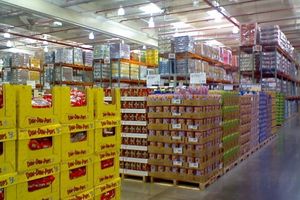 Costco is a membership-based warehouse club. While they do offer ready-to-go emergency food kits, they also have bulk, wholesale food items to add to your stockpile. The benefit of buying survival food at Costco is that you can buy a lot of great prepping items at an affordable cost than you would find in a grocery store.
Costco is a membership-based warehouse club. While they do offer ready-to-go emergency food kits, they also have bulk, wholesale food items to add to your stockpile. The benefit of buying survival food at Costco is that you can buy a lot of great prepping items at an affordable cost than you would find in a grocery store.
Related: What Happens When You Eat Only Costco Cans For 30 Days?
This is because you’re effectively cutting out the middleman costs of transporting food from the warehouse to the grocery store.
So, buying essentials for your survival stockpile at places like Costco can be a huge money saver, especially if you have a larger family or a bigger stockpile.
Walmart
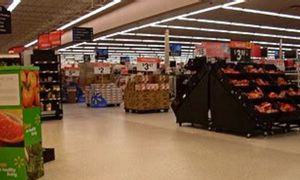 For some people, Walmart sometimes falls under the category of “necessary evil” – especially when it comes to buying survival food.
For some people, Walmart sometimes falls under the category of “necessary evil” – especially when it comes to buying survival food.
Where else can you buy a new toothbrush, a fishing license, and a 20 lb. bag of flour all in one store?
Whatever your opinion about Walmart may be, one thing’s for sure – It is a super cheap place to stock up on emergency food items and supplies.
To its credit, Walmart usually has a pretty impressive selection of food products at low prices. For example, they have a variety of canned foods as well as everyday items like sugar, flour, beans, and rice. They’re typically sold in a variety of sizes too — ranging from 3 to 50 pounds — so you can buy the right size for your stockpile needs.
Although Walmart is an affordable place to shop, the shipping, storage, and handling practices aren’t always perfect. So, checking for damage and other safety issues may be a good idea.
Grocery Stores
 Depending on where you live, grocery stores can be a good option for survival food purchases.
Depending on where you live, grocery stores can be a good option for survival food purchases.
Grocery stores usually carry MREs in the form of powdered milk, powdered peanut butter, freeze-dried meals, and other foods.
However, grocery stores also carry things like oatmeal, dried meat, rice, sugar, flour, and plenty of other shelf-stable food items for your emergency survival stockpile.
Although grocery stores aren’t necessarily the cheapest places to buy survival food, you can usually save a good amount by using a combination of free store cards and discount coupons in most cases.
Sam’s Club
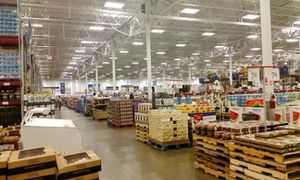 Sam’s Club is a great option for those looking to purchase bulk emergency food items at a discounted rate. As a membership-based subsidiary of Walmart, Sam’s Club offers its members access to wholesale food items at prices that are even lower than what you would find in Walmart stores.
Sam’s Club is a great option for those looking to purchase bulk emergency food items at a discounted rate. As a membership-based subsidiary of Walmart, Sam’s Club offers its members access to wholesale food items at prices that are even lower than what you would find in Walmart stores.
Many people prefer to buy cheap survival food at Sam’s Club since prices tend to be cheaper than they are at Costco, especially for larger or bulkier stockpiles.
This is another great option for those with larger emergency food stockpiles or those with big families.
Ethnic Food Markets
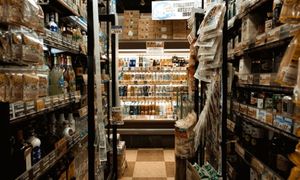 When looking for cheap survival food, markets that sell food items from other countries can be an unexpected survival food gold mine. From Hispanic and Asian to European markets, these kinds of stores tend to carry a variety of survival food items that are way off most people’s radar.
When looking for cheap survival food, markets that sell food items from other countries can be an unexpected survival food gold mine. From Hispanic and Asian to European markets, these kinds of stores tend to carry a variety of survival food items that are way off most people’s radar.
Related: 10 Long-Lasting Foods From The Chinese Store
This can work to your advantage when the usually frequented store shelves are starting to look a bit bare.
At these stores, you can usually find things like canned fish, dried meats, fermented foods, canned items, and more.
Culture-specific markets can supply you with a variety of low-priced, high-quality survival foods to add to your SHTF inventory.
Farmers Markets
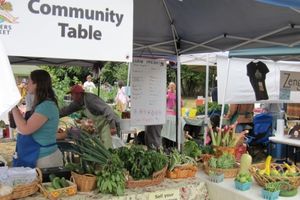
Farmer’s markets are a great place to buy food directly from the source while supporting your local farm community. Most farmer’s markets typically specialize in fresh produce, like fruits and veggies. However, a lot of markets also offer canned foods, dried meats, and other shelf-stable products.
Additionally, buying fresh produce to freeze-dry, can, pickle, ferment – or otherwise process at home – is often a healthier alternative to using store-bought produce for the same purpose.
Alternatively, you can grow your own vegetables, which would be even cheaper. For more helpful information, check out this guide on how to make a year-round self-sustaining garden.
When you purchase fresh produce at a farmer’s market, you can make your own canned, pickled, or fermented foods without all the unnecessary additives and preservatives required by the FDA just to sit on a shelf at a grocery store.
Buying produce at farmer’s markets allows you to make more types of foods specific to your own tastes.
This allows you to make things like fruit leather, veggie chips, unique dried powdered spices and herbs, and other similar items that cost less to make than the store-bought version.
Dollar Stores
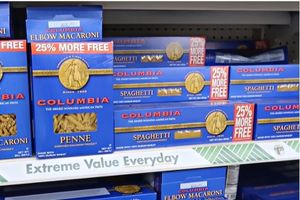 In North America, dollar stores – such as Dollar General, 99 Cent Store, and Dollar Tree – can be an unexpected source of ultra-cheap survival food.
In North America, dollar stores – such as Dollar General, 99 Cent Store, and Dollar Tree – can be an unexpected source of ultra-cheap survival food.
Dollar stores typically get their food from brand liquidation sales, lesser-known brands, or directly from global food manufacturers.
As a result, dollar stores are able to offer already discounted food at even lower prices. These kinds of stores can be a gold mine for shelf-stable foods such as canned items and dried products like pasta and rice.
So, the next time you’re looking for cheap survival food to add to your prepper pantry or emergency food stockpile, consider a trip to the dollar store.
From freeze-dried meals to canned goods and dried grains to dehydrated fruits and veggies, there’s plenty of cheap survival food to be found in stores – even if it isn’t necessarily marketed that way.
With a little planning and some frugal shopping skills, making your own survival food stockpile can be surprisingly affordable.
However, the stores mentioned on this list are just a handful of places where you can buy cheap survival food to add to your stockpile. What stores would you recommend for buying cheap survival food?
You may also like:
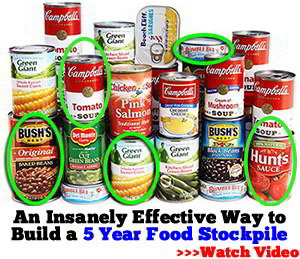 4 Shocking Survival Lessons From The Australian Pioneers
4 Shocking Survival Lessons From The Australian Pioneers
Why You Should Never Hide Your Survival Stockpile In Your Basement (Video)
The Best Way to Train Your Dog For Hunting And Security
How to Build an Endless Hot Water System (Without Electricity)

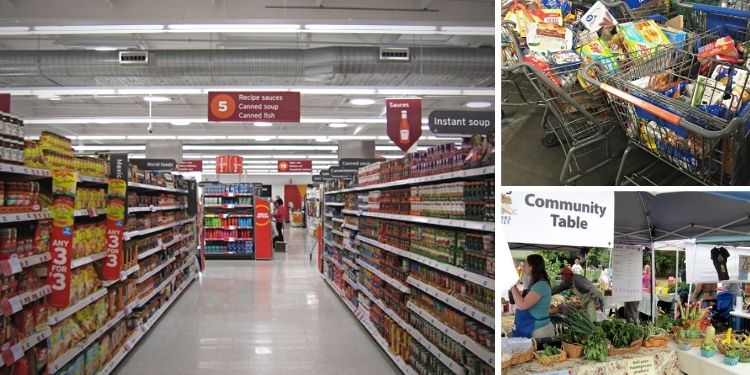




















One of my favorite places to buy survival food are Amish stores. These people have their own network of sources that may still be available when others are not.
Also, something that I find is really important regarding buying from local growers at farmers’ markets is that you are dealing with a producer who may also save seed which means that their food is likely to be available after SHTF. If you are able to figure out a barter system with them (or are in a MAG group with them), you’re that much ahead than you would be simply having survival foods prepped.
Ethnic Food Markets can also be a source of bulk dry foods like beans ( pinto, navy and black turtles for example) and peas, lentils, and rice. For me i am lucky all but rice is readily available direct from local farms in bulk.
LOL. Costco isn’t a wholesaler of anything. Their prices on food are not much better than just buying at the grocery store during a sale. Great quality on meat and produce, but unless your freeze drying or canning, those things are prepper purchases. Ditto for Sam’s.
The trick is knowing what you’re actually paying per unit. Do the math and know what a regular price is and what a good price is. (Harder to do with the price increases over the past year.)
Learn which products have good quality generic substitutes and which ones don’t. Oatmeal? Doesn’t matter so much, but the difference between some canned goods is noticeable. Stock up on what’s on sale at a discount and never pay full price. Most foods go on sale in cycles.
I love ethnic stores for great prices on certain foods, especially spices and various grains and legumes.
Walmart never heard of it
I would not go to Wal-MArt if it was free! Dont ever shop at at any place that is know for child trafficking! when you do you are particpating in child trafficking!!!
Lol sure they do
This person is bound to a false narrative. I wouldn’t shop at Walmart because it’s a store that prices out local stores, doesn’t pay their employees enough to live, and treats them horribly. They also got rid of DEI. I know that some preppers will hate me for that last one, but DEI includes a whole crapload more than just sex and race. If you look close enough some of the DEI benefits probably hit close to home.
VALERAMA: We find that what Oatmeal you eat DOES make a big difference (esp. so do the Quaker Oats and all oat cereals/products!*). Most oats now days are SLATHERED * with Round-up weed killer to dessicate them all at once. Personally, I’d rather not be eating Quaker Oats’ weedkiller, thinking I’m helping my heart! Everytime we see a commercial for Honey Nut Oats or similar, we end up yelling at the T.V. about how heart healthy they are, because they are POISONED!
On the otherhand, we can buy 25# bags of either organic (zero weedkillers) oats or even gluten free organic oats* grown on the high plains in Colorado! The cost is quite a bit less than $3.00/lb….like anywhere from $2.20 to $2.72/lb. for 25# bags that you can order at your local
co-op! We love the Golden Prairie* Oats from Colorado. The consistency, flavor and quality are superb and they are actually very healthy for you!
We also found you can buy an 18 lb. bulk bag of Himilayan Basmati (I think?) Rice at Walmart for $18.00. Actually, I don’t know the exact price anymore, cause we bought ours about 1 yr. ago. However, food grown in or near the Himalayas is generally pretty “clean” of toxins.
Joyce S., Certified Natural Health Professional since 2006
A big ol F. Walmart, child traffing bastards,
You are applying ‘Americanized’ morals to something no one has any business sticking their noses in except the parents who ALLOWED it to happen.
The only place you might get good deals on food is a farmers’ market or dealing directly with farmers.
When buying from chain stores such as Walmart make sure you look at the date codes, prices compared to other stores and quality.
Chain stores are notorious for marking something one price and when you check out the price is 20 to 30% higher. An example At Walmart I went to buy a grill type hot plate it was marked at 20.99 and when I checked out (auto teller which I hate but no lines to use) it tried to charge me 29.99. So, I called an employee. The employee tried to tell me it was not marked that. So, I went back to where I got it and took a picture (10 minutes). He then said it was a mistake and I would have to pay the 29.99. I then asked for a manager and the manager had to go back (another 10 minutes) and see for himself then finally after 30 minutes he allowed me to pay only 20.99 for it. So, even when you are right, they make it so hard that I have from then on left it on the counter and just told the clerk or whomever the price was marked wrong, and I do not want it that new price. I then walk out without buying it. Saves me time and makes Walmart have less sales. Reason for leaving it, 30 minutes is too long, and I had rather go online and make the purchase for that and pay most of the time less for the item.
That brings up another point it seems that online is in most cases cheaper than from a store. Even from those chains that have online purchasing if you watch closely the in-store price is higher in some cases.
I’ve said before here to be cautious when shopping at Dollar-type stores. Years back, I was part of an investigative team that worked mostly on intellectual property crime, mostly because it was so heavily controlled by the Asian gangs. We raided dollar stores repeatedly – they had substandard and very dangerous power bars and extension cords that constantly caused fires, and, in one case, were selling “Potatoes from New Brunswick, Canada” that were actually some weird back-alley brand from China that had the old labels torn off, and the fake ones put in their place. We even heard rumours of counterfeit chocolate bars. Their toys and plastics are often toxic as hell, and the toys shatter into razorlike shards if you give them a stern look. I’ll buy things like wrapping paper, or a wooden spoon there, but I won’t touch food, toys, or electrical products.
This wasn’t exactly enlightening! Who wouldn’t think about each of these stores? The ethnic food one was likely the only suggestion new to some people!
Then how about you do an article. Geez!
Costco is not 2A friendly so we canceled our membership years ago and switched to Sam’s Club. I used to miss some of the Kirkland items but I found I could easily live without them.
I don’t think the author of this article understands the full meaning of MRE. Buying the ingredients for a meal and putting them into a vacuum-sealed bag or mason jar is not quite “Ready to Eat,” especially if you are in the process of evacuating and don’t have access to a kitchen or modern shelter. And I don’t recall seeing packages of food that include a heating method, except for some self-heating cans of hot chocolate many years ago (it was mediocre hot chocolate for way too high a price) at any of the places mentioned in the article. The article was well written, without the usual typos and poor grammar that are so common on every website these days, but I would take some of the information with a grain of salt.
On another note, I wish we had a farmer’s market around here. I am in a very rural area so my theory is that everyone around here has their own garden, therefore they don’t feel any need to buy from others’ gardens. Such a shame because I often end up with an over-abundance of one or two things (usually melons, tomatoes and lemon cucumbers) but can’t seem to grow a few others (peas, green cucumbers and peas) at all. I would love to find a network of locals who would trade or sell various garden produce to each other.
Just got back from Costco and Sam’s. Costco has by far the most bulk items, (here in MO), in our market. Sams has cut down to only 25lb bags of white rice and 12lb bags of pinto beans. Costco has the 25lb bags of sugar, several types of rice and other items. But yes, watch the unit prices. Also, heat seal mylar bags with oxygen absorbers have gone up considerably too.
This all being said, it is WAY cheaper to get the same protein in bulk buys as from ANY commercially packaged/freeeze dried foods. You can get the same proteins, (beans, rice and pasta), MUCH cheaper in bulk. And remember, salt is a BIG item you can’t forget.
My father use to say that if you’er hungry you’ll eat just about anything. In a survival situation I want to eat foods that pack the best and most balanced nutrition possible. They say you get what you pay for, so I buy what I like and what my family likes to eat. When it’s on sale I take advantage of it with bulk buys to fill the pantry. So, the store in and of itself doesn’t matter
I recently found out about real bread and it’s benefits. There is a woman, Sue Becker. She is a nutritionist. Her family owns a store in GA. I quit eating bread several years ago because it is processed and worthless. I heard Sue speak on a program and did some research. Wheat berries can last literally centuries if stored properly. Studies show you can literally live on wheat and beans ( like Ezekiel bread). I started buying wheat, oats, honey etc. From breadbeckers coop. Great source for survival food.
Amish dry goods store are reasonable priced and has the basics. I also like the fact that I am giving back to my friends.
i don’t think there is a single amish person living in hawaii. i need to research their culture. i don’t know what they eat except for assuming it is mostly home grown meat, fruit and veggies. are there any stores that sell anything amish in hawaii?
There’s an Amish Store in Mid-Town Manhattan on the west side, but it’s mostly a fresh food grocery and unfortunately not a lot of dry goods in stock. Would be tough to get it home anyway on the subway.
Stay away from anything with “natural flavor.”
Research it.
I pretty much shop exclusively at Walmart because that’s the only place I can get a pair of pants, groceries and oil and a filter in one stop, lol. So before all the haters criticize me, STUFF IT. That being said, Walmart sells 72 hour buckets of freeze dried “emergency food” for one at a reasonable price. The last time I bought I think I paid $25 for the bucket. Lately I have seen them in the bulk section in the grocery aisle, but I think I originally saw (and bought) them in the sporting goods department. Check both. You’re welcome.
Buckets of FD food are ALL garbage, except Mountain House.
Tell that to starving people who haven’t had anything to eat for a week or more. They’ll likely share a differing opinion. Not to mention, you sound like a shill.
I glean tree fruits that owners aren’t picking in the city over an hour from here. An afternoon or two is a great investment in fruit to can or dry.
I also get food from a community pantry. Lots of canned goods, dry beans, lentles, peas ect. Also rice, nuts, powdered milk and instant potatoes. Much of that is excess for just me so is stored back. There are often 3 serving mylar packs of beef stew and chili con Carne with beans. Much of that has been stored. Also occasional 1/2 gallons of shelf stable milk with 1 or more years future use by dates. I can up any excess chicken, ground beef etc. And at times make thick soups or stews that I can just heat and eat. Even dry beans can be canned ready to heat and eat. I tried a few mylar packs laid on the front dashboard of the truck in full sun. They warmed enough to taste good to eat “as is”. To extend for guests I serve them over rice. I have ways of easily heating any food from tiny wood burning backpack stoves to homemade alcohol burners from a soda can. I hope to never need to relocate in an emergency but can if needed. Doing the same for a friend. Also making up a get home bag for my friend. I keep a few things in my vehicles at all times in back packs. Plenty for surviving a few days minimum. I keep some bottled water and flavorings to make warm water more palatable.
I make cheeses if and liquid milk nears the end of the use by date. And try to use older things as I get newer foods. Simple plan, but it’s kept me in plenty through some mighty hard lean times over the years and the entire months or more that I couldn’t go shopping for one reason or another. When it was possible to get case prices on canned goods I also stocked up. Canned meats are heavy on tuna, spam, chili with meat and even some not so favorite Vienna sausages.
The farmers market around here is once a month and it’s not cheap. The products are great but, it comes at a cost that is much higher than mass produced products that are sold at the Walmart type stores. I went to a Walmart last November and a five pound sack of potatoes was ten dollars. I was in sticker shock. I don’t know what the price is now. Maybe it has come down. Anyway, I planted some potatoes. Three hundred yards of potatoes. It took me about six hours. They’ll keep for about six months and I’ll trade them with other growers for different vegetables.
One of my new “Happy Place” is Dollar General. Just for fun I went to one, and for $20.00 dollars I was able to buy some canned and dried food, Crackers, a summer sausage, processed cheese (for the crackers) some candles, a few packs of AA batteries,a bottle of water and a book ( a post-apox,sci-fi book BTW) I still had enough change to by a candy bar. You should try this, just for fun, or as a teaching tool for your kids.